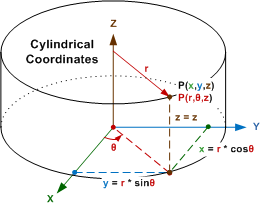
...to Cylindrical
r = (x2 + y2)½
θ = tan-1(y/x)
z = z
...to Spherical
ρ = (x2 + y2 + z2)½
θ = tan-1(y/x)
Φ = cos-1[z/(x2 + y2 + z2)]

...to Rectangular
x = r * cos(θ)
y = r * sin(θ)
z = z
...to Spherical
r = sqrt(x2 + y2)
ρ = tan-1(y/x)
z = z

...to Rectangular
x = ρ * sin(Φ) * cos(θ)
y = ρ * sin(Φ) * sin(θ)
z = ρ * sin(Φ)
...to Cylindrical
ρ = (r2 + z2)½
θ = θ
Φ = tan-1(r/z)
There are three fundamental three dimensional (3−D) coordinate systems (rectangular, cylindrical, and
spherical), each of which is a more convenient means for calculations depending
on the configuration of your model. For example, mapping points on the surface of
a sphere using the Cartesian coordinate system requires describing all three coordinates
(x, y, and z) in terms distance from each of the threes axis references. Doing
the same in the spherical coordinate system requires simply a radius and two angles.
When you start doing very complex calculations like those requiring calculus applications,
choosing the best coordinate system can make the difference between nightmarish
equations and relatively simple ones. Conversion formulas between the three fundamental
coordinate systems are as follows. Note that N½ = square root
of N.
Given rectangular coordinates (x, y, z), convert to cylindrical coordinates (r,
θ, z):
r = (x2 + y2)½
θ = tan-1(y/x)
z = z
Given rectangular coordinates (x, y, z), convert to spherical coordinates (ρ,
θ, Φ):
ρ = (x2 + y2 + z2)½
θ = tan-1(y/x)
Φ = cos-1[z/(x2 + y2 + z2)]
Given cylindrical coordinates (r, θ, z), convert to rectangular coordinates (x,
y, z):
x = r * cos(θ)
y = r * sin(θ)
z = z
Given spherical coordinates (ρ, Φ, θ), convert to rectangular coordinates (x,
y, z):
x = ρ * sin(Φ) * cos(θ)
y = ρ * sin(Φ) * sin(θ)
z = ρ * sin(Φ)
Given spherical coordinates (ρ, θ, Φ), convert to cylindrical coordinates (r,
θ, z):
r = ρ * sin(Φ)
θ = θ
z = ρ * cos(Φ)
Given cylindrical coordinates (r, θ, z), convert to spherical coordinates (ρ,
θ, Φ):
ρ = (r2 + z2)½
θ = θ
Φ = tan-1(r/z)
Here is a convenient online
coordinate system converter on the Random Science Tools and Calculators
website.
Posted September 15, 2023
(updated from original
post on 2/4/2009)
|










